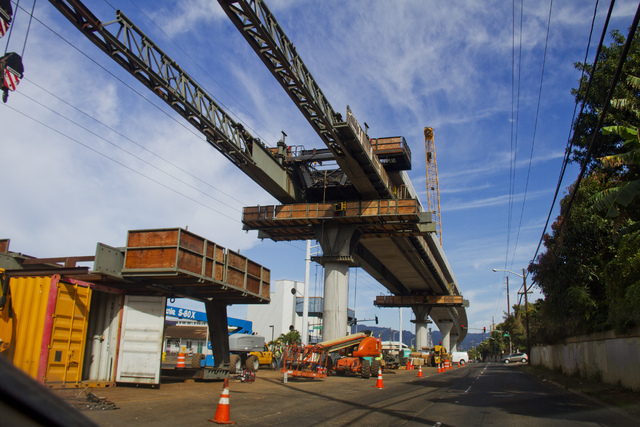Honolulu rail’s federal partners say they estimate the transit project won’t be completed until December 2024 — about five years behind the original schedule — while costing $900 million to $1.2 billion more than local rail officials’ latest price estimate.
The Federal Transit Administration’s estimate of how long it will take to finish rail, provided in a statement from an agency spokeswoman Monday, exceeds the latest estimate provided by the local Honolulu Authority for Rapid Transportation by more than two years.
Under the city’s 2012 funding agreement with the FTA — a deal that secured $1.55 billion in federal funds for rail — project officials agreed to complete the entire 20-mile project by the end of 2019 and provide
service from East Kapolei to Ala Moana Center by Jan. 30, 2020.
The FTA’s statement did not say why it will take so much more to complete Oahu’s transit project.
“They just don’t think we’re going to progress as quickly as our staff does,” HART board member Mike Formby, who also serves as the city Department of Transportation Services director, said Monday. Formby and board Chairwoman Colleen Hanabusa sat in on meetings with FTA officials on Oahu last week to discuss the budget and schedule challenges facing rail.
“We will work with HART to ensure it is taking every reasonable measure to mitigate cost overruns and minimize the delay in opening the project,” the FTA statement read.
It confirmed what Formby and Hanabusa revealed several days ago: that the federal agency contends rail will cost as much as $8.1 billion to finish. However, the FTA also clarified Monday that its cost estimate is at least $900 million more than HART’s latest estimate, not $700 million as Hanabusa and Formby had stated. Formby said Monday that the $700 million figure was an error on their part.
HART and the FTA will now try to sort out the differences in their estimates. Local officials, meanwhile, will grapple with how best to guide a transit project on course to exceed its budget by as much as $1.3 billion.
They also have come under criticism about rail — currently the nation’s most expensive such transit project per capita by far and the largest public works project in state history — as its costs continue to climb.
“I’m very disappointed but I’m not surprised,” City Councilwoman Ann Kobayashi, the Council’s budget chairwoman and longtime critic of HART, said Monday of the latest federal estimates.
“There are some who say it might go up to $10 billion. It’s not a good situation to be in,” Kobayashi added. “You look at all those columns going up … it’s sad.”
Kobayashi’s colleague on the Council, Transportation Chairman Joey Manahan, called it “unrealistic” to say rail officials could rein in costs by about $1 billion and still keep the project as a useful public transit alternative to the H-1 freeway.
“How much can you really cut from the project and maintain all those things?” Manahan said Monday. “At some point you’re going to have to think about another (general excise tax surcharge) extension or some other source to make up the difference. So whether that’s going to be property taxes or some other revenue stream, those things have to be discussed.”
Manahan said HART has done a poor job handling the budget information and “sticker shock” for rail — and that it’s eroding public trust in those managing the project. “They have to get a better handle on the numbers they’re giving us,” he said.
Meanwhile, Council Chairman Ernie Martin said in a statement that he does not support extending the GET surcharge past its agreed-upon levels in this year’s five-year rail tax extension. Thus, Martin wrote, “going back to the Legislature is not an option.”
Instead, Martin called on rail’s “public and private partners (to) step forward with additional capital investments” to help make up the looming budget shortfall.
Martin’s political rival, Mayor Kirk Caldwell, praised the “openness and transparency” of Formby and Hanabusa, who remain Caldwell’s two top allies on the HART board.
“We will work collectively with the Honolulu City Council Chair and Council members, the HART board, and the Federal Transit Administration on a path forward to deliver this important transit project to Oahu’s residents,” Caldwell, a longtime rail supporter, said in a statement Monday. “The only way to solve this is to work together.”

